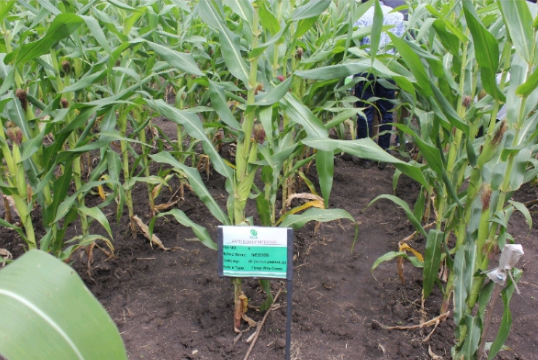In the media
Exotic wheat DNA helps breed ‘climate-proof’ crops
 Climate adaptation and mitigation
Climate adaptation and mitigation
Source: Phys.org (10 Jan 2023)
Wheat containing exotic DNA from wild relatives benefits from up to 50 percent higher yields in hot weather compared with elite lines lacking these genes, according to a new study.
Taking Aim Against the Dire Threat of Fall Army Worm
 Environmental health and biodiversity
Environmental health and biodiversity
Source: The Farming Forum (30 Dec 2022)
Latest progress on fall armyworm prevention and protection show signs of success for smallholders.
Mexico Agriculture: Thrive on the Shift from Efficiency to Resiliency
 Climate adaptation and mitigation
Climate adaptation and mitigation
Source: AgNews (29 Dec 2022)
CIMMYT Director General Bram Govaerts looks at challenges facing Mexican and global agricultural systems.
Rear fish in a rice paddy? Old ways can future-proof food production
 Nutrition, health and food security
Nutrition, health and food security
Source: South China Morning Post (18 Dec 2022)
CGIAR scientists share the importance of testing new research models for integrated aquatic and terrestrial production systems.
How a policy to address a groundwater shortage inadvertently increased air pollution in northern India
 Climate adaptation and mitigation
Climate adaptation and mitigation
Source: Tech and Science Post (15 Dec 2022)
The seemingly small shift in the planting season had a cascading effect that delayed the fire season by about two weeks and exacerbated air pollution.
Combining improved seed varieties and index insurance to address drought losses
 Climate adaptation and mitigation
Climate adaptation and mitigation
Source: VoxDev (5 Nov 2022)
Paswel Marenya, Adoption and Impact Assessment Economist at CIMMYT, explains on a podcast how bundling genetic and financial technologies can make small-scale agriculture more resilient and productive.
A renewed CGIAR can better support South Asia to determine its food future
 Climate adaptation and mitigation
Climate adaptation and mitigation
Source: Mongabay (13 Dec 2022)
Temina Lalani-Shariff, Regional Director of South Asia at CGIAR, explains CGIAR is evolving so that it can continue to be the scientific partner of choice for national research institutes and governments.
Decolonization should extend to collaborations, authorship and co-creation of knowledge
 Gender equality, youth and social inclusion
Gender equality, youth and social inclusion
Source: Nature (22 Nov 2022)
Sieglinde Snapp identifies opportunities for improving inclusivity in the biosciences.
Feature: Reciprocal cooperation between China, int’l agricultural research agency safeguards food security
 Nutrition, health and food security
Nutrition, health and food security
Source: Xinhua News (23 Nov 2022)
Four decades of partnership between China and CIMMYT is supporting global efforts to achieve food security.
Sustainability, quality concerns take center stage at Cereals & Grains 22
 Climate adaptation and mitigation
Climate adaptation and mitigation
Source: Baking Business (16 Nov 2022)
At Cereals & Grains 22, Bram Govaerts, Director General of CIMMYT, explains the activity needed to adapt agriculture to the impact of climate change.
Kenya: Scientists team up to control fall army worms
 Environmental health and biodiversity
Environmental health and biodiversity
Source: Agro News (9 Nov 2022)
Scientists are working to contain the spread of fall armyworm in Kenya with naturally resistant varieties and eco-friendly solutions.
‘Perennial’ rice saves time and money, but comes with risks
 Nutrition, health and food security
Nutrition, health and food security
Source: Science (7 Nov 2022)
Research on rice crops that do not need replanting in China is showing promising results for yield, finances and labor, and the environment.
Farmers introduced to stress-tolerant hybrid maize varieties
 Environmental health and biodiversity
Environmental health and biodiversity
Source: Ghana Business News (2 Nov 2022)
A field day in Ghana organized by the AGG project supports farmers to adopt maize varieties with tolerance to stress.
Kenya Lifts 10-year Ban On GM Foods, Allows Open Cultivation, Importation Of White GM Maize
Source: New Nigerian Newspaper (20 Oct 2022)
Food crops and animal feeds produced through biotechnology innovations can now be imported into Kenya after the ban on genetically modified organisms (GMOs) was lifted.
Leading Norwich plant scientists call for action to mitigate food crisis
 Nutrition, health and food security
Nutrition, health and food security
Source: Eastern Daily Press (15 Oct 2022)
A tiered approach is needed to tackle food crises and wheat shortages triggered by the Ukraine-Russia crisis.













